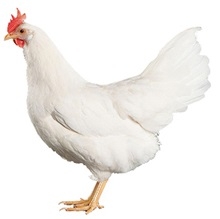 (chicken).jpg) Bird flu (Avian influenza):
Bird flu (Avian influenza):
It is caused by influenza and it increases the death rate 100%. The infection comes out through the respiratory pipe, tears and waste. The disease spreads very early from one chicken to another. It can also spread through unhealthy food and water utensils, cages and clothes. The symptoms are lazy chickens, less hunger, less egg production, comb color turns yellow, and early death.
Prevention: Stop taking anything inside or outside from chicken farm. Separate shoes will be used inside the farm. Make the hole and add medicine in mentioned amount so that before entering the farm dip your foot in the treated water. Germ destroyer such as Qualitol should be sprayed around the farm.
Cautions during disease: Because this disease affects the human, wear proper clothes and gloves before picking the diseased chickens. Burn or bury the dead and influenced chickens in the soil. Meat can be made at 70oC as it kills the infection and it is used for eating.
.jpg) Vitamin A deficiency:
Vitamin A deficiency:
The symptoms of this disease are beak and legs get fainted yellow and shaking head.
Treatment: Add more amount of Vitamin A in the feed and gave them green feed.
Fainted paws:
The disease is mainly caused due to vitamin B2 deficiency and it is mainly seen is growing animals. The symptoms are paws turn inside.
Treatment: Add Vitamin B2 in the feed.
.jpg) Vitamin D deficiency:
Vitamin D deficiency:
The disease is mainly caused due to vitamin B2 deficiency or due to an imbalance of calcium and phosphorus in the body.
Treatment: Add Vitamin D3 in the feed.
.jpg) Chicken pox:
Chicken pox:
It is a contagious disease and it can be spread in any age of the bird. The symptoms are sores on a comb, around eyes and ears.
Treatment: Homeopathic medicine of antimonium torterix @5ml/100 birds is given to cure chicken pox.
.jpg) Coccidiosis:
Coccidiosis:
It is a parasitic disease which is caused by coccidian protozoan. The disease is mainly caused to the chick having age between 3-10 weeks. It also affects the adult ones.
Treatment: Proper cleaning should be done. Approximately up to 12 weeks chick’s give coccidiostat in the feed, for eg befran or amprol @50g/qtl feed, clopidol @125g/qtl, stanorol @50g/ton of feed. Change the medicine after every 1-2 years. Mix the medicine properly in the feed.
.jpg) Leucosis and marek’s:
Leucosis and marek’s:
It is a contagious disease which is infected to another animal via air, feathers, soil etc. Leucosis doesn’t spread through air and doesn’t spread through the polluted environment.
Marek’s symptoms: It is mainly caused to chicks having age between 1-4 months and sometime it is caused to 30 days old chicken. The symptoms are fainted legs, feather and neck, grey color eyes and ultimately they get blind.
Leucosis symptoms: It is mainly caused to chicken having age more than 4 months. They symptoms are increase in liver in size and ulcers are found in all body parts except veins.
Treatment: When the chick is one day old vaccinate them with Marek’s vaccine. Proper cleanliness and care should be taken.
Ranikhet disease:
It is also known as New Castle disease. It is a very contagious disease and it is spread to every age bird. The symptoms are increased death rate, difficulty in breathing, fainted legs and feathers.
Treatment: When the chicks are 1-6 days old vaccinate it with Ranikhet medicine of F strain and broilers should be vaccinate after 4 weeks interval with F-1 vaccination.
Fatty liver syndrome (FLS):
The disease is mainly caused due to feed digestion problem which causes fat deposition in the body. This disease is mainly found in egg producing chicken or broiler which has given more energy feed. The symptoms are 50% less egg production, weight reduces up to 20-25% and blood spots are seen on liver and body.
Treatment: Decrease the energy content in the feed. Mix 100g choline chloride, 10,000 I U Vitamin E, 1.2mg Vitamin B12 and 100g incitol in 1 quintal of feed.
Aflatoxin:
It is mainly caused due to humidity and hot rains. The symptoms are less hunger, less egg production, increased thirst and decrease in blood level.
Treatment: Livol or liv-52 or tefroli tonic is given in feed or given through water. Vitamin A and Vitamin E @60,000 IU/acre and 300 IU/acre is given respectively.


 (chicken).jpg)
.jpg)
.jpg)
.jpg)
.jpg)
.jpg)










